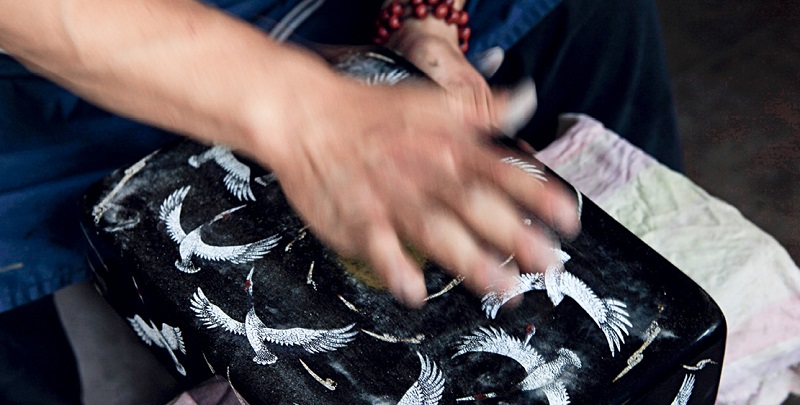
An artisan is polishing a Pingyao-style lacquerware.
Pingyao hand-polished lacquerware has been widely considered as one of the four most famed lacquerware types in China. It originated more than 2,000 years ago in what is called Pingyao County today, in Jinzhong City, central China’s Shanxi Province. Its fame is due to the exquisite and unique skill of polishing lacquered coating with bare hands during the manufacturing process. This quaint and durable lacquerware boasts both aesthetic and practical values, and is characterized by its distinguished appearance and glossy sheen. It comes in the forms of jewelry boxes, utensils and stationery, screens and furniture.
Pingyao hand-polished lacquerware gained fame during the Tang Dynasty (618-907) and reached its peak in the Ming (1368-1644) and Qing (1644-1911) dynasties during which it was taken across China by Shanxi merchants whose businesses were expanding rapidly. In 2006, the technique used to produce Pingyao hand-polished lacquerware was included on the list of national intangible heritage items.
Its complex production process involves steps such as making a wood framework, applying plaster, lacquering, painting, and inlaying. First, a basic structure made of basswood is created. This is followed by wrapping the frame in multiple layers of hemp cloth and applying plaster to the exterior. After that, the designer begins to apply several layers of lacquer. When the varnish dries, it is polished with different tools. Then comes the most important step — polishing the lacquered coating with bare hands. The strength applied and even the temperature directly affect the luster of the finish. During the final step, elaborate motifs and patterns are painted and glittering embellishments inlaid.
Pingyao’s lacquer objects use fine natural materials: natural pigments are used to paint various patterns, and a range of materials are used for decoration including gold and silver sheets, gold and silver powders, mother-of-pearl, bones, and stones. Lacquer is the essence of this craft. Pingyao artists use the sap of a species of lacquer trees that grow widely on the Loess Plateau to make lacquer because it has the advantages of being moisture-proof, durable, and having an attractive luster. The selection of lacquer, the proportion of ingredients, and the drying time all require expertise and experience.
Today, Pingyao hand-polished lacquerware incorporates contemporary elements to meet the taste and needs of the current era, coming out with varied and interesting implementations such as exquisite bookmarks, small earrings, bracelets, pendants, and cosmetic facial mask boxes, which are popular with customers. In recent years, Pingyao County has hosted art festivals and established associations centering around Pingyao hand-polished lacquerware. At the same time, Pingyao lacquerware masters set up studios to train apprentices and pass on their skills. Lacquerware classes have been opened in some schools, giving this traditional craft a new lease on life. 